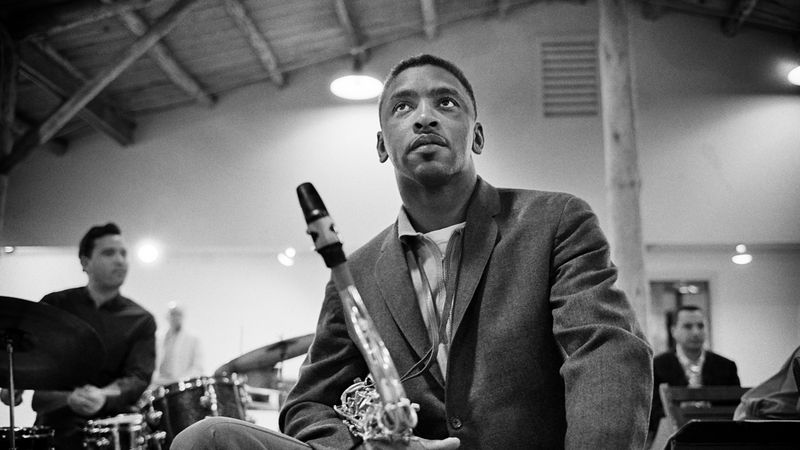THE JOURNAL

Mr Teddy Edwards, Monterey 1963. Photograph by Mr Jim Marshall Photography LLC/Reel Art Press
The Ivy Look might have come out of the elite American private schools, but it took bebop and jazz musicians to make it cool. Here’s what you can learn from their improvised styles .
Jazz has always been revolutionary. To music, it brought a new sense of rhythm, structure and harmony that rewrote all pre-existing rules. To a segregated the post-WWII US, it brought an opportunity for integration with its bars, concerts and festivals – events where black people and white people would congregate together, long before such fraternising ceased to be taboo.
It was also, of course, utterly game-changing when it came to style – little says that more than the fact that jazz gave us (or at least popularised) the words “hipster” and “cool”. And it had the clothes to match. This latter point becomes particularly clear upon flicking through Jazz Festival: Jim Marshall, a new, and rather awe-inspiring new photo book from Reel Art Press that collects legendary music photographer Mr Jim Marshall’s photographs of the Monterey and Newport Jazz Festivals from 1960-66.
The black-and-white images gathered here depict both the known and unknown – on one spread you might see bebop pioneer Mr John Coltrane performing on stage, on another, an assorted bunch of festival attendees sipping drinks in front of the bandstand. What unites them all is their ultra-sharp clothing, extolled at length by Mr Graham Marsh in his introductory essay, in which he describes the 1960s jazz festivals in Monterey and Newport as “a veritable catalogue of Ivy cool.”
That given, jazz hipsters had their own, timelessly stylish take on the Ivy Look, which still has many lessons to teach us, in this much-less-hip future we now inhabit. Here’s a few, drawn from some of MR PORTER’s favourite images from the book, which is out now.
Wear Sunglasses Constantly

Monterey, 1963. Photograph by Mr Jim Marshall Photography LLC/Reel Art Press
Ray-Ban and Persol sunglasses were the accessory of choice for jazz enthusiasts in the 1960s, according to Mr Marsh. More importantly, it seems, they wore them all the time, indoors and out, through good and bad weather. Use this as justification for keeping your favourite pair on well until October (or so long as there are some mind-frazzling beats keeping your toes tapping).
Try these
Embrace The Camp-Collar Shirt

Messrs Dizzy Gillespie and Lalo Schifrin, Monterey, 1961. Photograph by Mr Jim Marshall Photography LLC/Reel Art Press
This impeccably cool picture of a young Mr Lalo Schifrin (the Argentine composer of the Mission: Impossible theme, caught here smoking a pipe next to Mr Dizzy Gillespie) demonstrates what we at MR PORTER have often claimed, that the camp-collar shirt is a garment that looks as languidly elegant now as it did when it was first popular, in the 1950s and 1960s. We’re also rather keen on the high-waisted trousers – but admittedly, they’re a rather tougher sell for modern times.
Try these
Wear Something Else With Your Blazer

Mr Teddy Edwards, Monterey, 1963. Photograph by Mr Jim Marshall Photography LLC/Reel Art Press
Yes, jazz is all about improvisation, a technique which can also be applied to your sartorial situation. Here, the tenor saxophonist Mr Teddy Edwards swaps his shirt for a half-placket pullover shirt, which he wears over a white tee, resulting in an unexpected combination we have never previously recommended, but which we’re sure you’ll agree looks rather good. Now it’s time for your solo…
Try these
Cover Up With a Chunky Cardigan

Monterey, 1960. Photograph by Mr Jim Marshall Photography LLC/Reel Art Press
The shawl-neck ribbed cardigan is an Ivy classic, particularly when paired with wool slacks, such as the above. What’s particularly nice about the way its worn by this attendee of the 1960 Monterey Jazz Festival is that the fit is slightly oversized and the weight of the sweater is balanced out by the considerable heft of his eyewear.
Try these
Mix checks and stripes

Messrs John Handy and John Hammond, Monterey, 1965. Photograph by Mr Jim Marshall Photography LLC/Reel Art Press
Checks and stripes, together, is not an easy thing to pull off, but Mr John Hammond, the man who first signed both Ms Aretha Franklin and Mr Bob Dylan (pictured here with great alto saxophonist Mr John Handy), does it here with aplomb. We would recommend following his lead, if you want to try the look, and opting for two different patterns of a slightly differing scale, to create contrast rather than clash.
Try these
Jazz Festival: Jim Marshall (Reel Art Press) is out this month